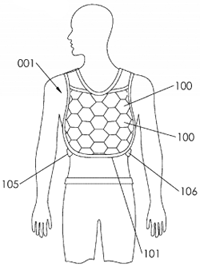 The Phase Change Matters e-mail newsletter is a weekly summary of the latest news and research on phase change materials and thermal energy storage. To subscribe, visit www.puretemp.com/subscribe. For more frequent updates, follow @puretemp on Twitter or visit the Phase Change Matters blog,
www.puretemp.com/pcmatters.
The Phase Change Matters e-mail newsletter is a weekly summary of the latest news and research on phase change materials and thermal energy storage. To subscribe, visit www.puretemp.com/subscribe. For more frequent updates, follow @puretemp on Twitter or visit the Phase Change Matters blog,
www.puretemp.com/pcmatters.
NEW PRODUCTS
Tennessee startup introduces PCM-equipped dog cooling collar
In extreme heat, active dogs need more than water and shade to avoid heat stroke. Canine cooling vests and evaporative collars have been on the market for years. A Tennessee company recently added a new product to that list: a PCM-equipped canine collar designed to suppress body temperature during rigorous physical activity.
 T-CoolK9 launched its website, t-coolk9.com, in mid-March and made its first sale a week later. For Blake Fohl, the company’s chief operating officer, T-CoolK9 is both a passion project and a full-time job. He began working on the product about a year ago.
T-CoolK9 launched its website, t-coolk9.com, in mid-March and made its first sale a week later. For Blake Fohl, the company’s chief operating officer, T-CoolK9 is both a passion project and a full-time job. He began working on the product about a year ago.
Q: What sparked your interest in developing a cooling product for dogs?
A: “I was approached by an individual who had an idea, but didn’t know how to bring it to market in the right way. My wife has been breeding German shepherds for two decades. We have dogs all over the world and doing about anything a dog can do, so we understood the dangers of canine heat stroke. I felt if there was a significant market, if the product could be proven to work as intended, it would be worth the time to create a new company from scratch.”
Q: How did you arrive at the design of the cooling collar? It’s different from competing products.
A: “We enlisted the help of a research scientist with an competency in biology and physiology. Our objective was to obtain a real grasp of how canines cool themselves, and to conduct trials which demonstrated the ability to reduce the dog’s blood temperature. During our research of other products, we found they either had no scientific research behind them, or they just don’t work. Dogs cool themselves through respiration primarily and to a very small degree through vascular temperature transfer in the feet and around the anus. That knowledge, in itself, led to the design of the collar. Looking at the arterial and vascular pathways really explains the design. Heat deflection sheets actually have the opposite effect. Water evaporation vests simply add weight to the dog and as you now know, they don’t cool themselves that way. Other products which use ice packs, or maybe even phase change material, place the packs in the wrong position.”
Q: How did you arrive at the melt point of the PCM (8°C)? Other products use 15-18°C.
A: “We identified pretty quickly that the PureTemp 15 we initially tested just wasn’t cool enough, especially with double-coated dogs, such as German shepherds. So the scientist, a really smart guy, did some calculations and, working with PureTemp, we landed on PureTemp 8.”
Q: How much PCM, by weight, is used in each collar?
A: “There are three PCM packs in the collar, two in the neck and one in the chest. We are averaging around 200 grams per collar.”
Q: What kind of feedback are you getting from dog owners?
A: “It has been a little overwhelming. From search-and-rescue teams, police dogs, sport dogs, from people who do serious hiking with their dogs to owners who are just active with their pets, people are falling in love with the product. I think it is due to two reasons. First, the owners have a sense of confidence that they are doing the right thing to keep their dogs safe and comfortable, and secondly, they tell us the dogs actually get excited when they put the collar on.”
Q: The collars are designed to fit all dogs with neck circumference of 10 inches or more. Do you plan on offering additional sizes?
A: “If the demand is there, we will make it. Our collar can fit any dog with a neck of 10 inches up to about 34 inches. That’s a big dog. Seventy-five percent of the registered dogs in America fall into that range.”
Q: Your site mentions that a portion of the profits from the sales of our product will be reinvested in additional scientific research. What’s the focus of the research?
A: “We will be working with our original scientist and he is exploring creating a group of scientists and technologists to help understand the problem of canine heat stroke better and create new products and technologies to prevent the deaths of dogs. I could write for hours about how complicated this issue is, and how difficult it is to identify all the variables that go into creating a solution. We have a good first solution to help prevent the problem, but it is not the ultimate fail-safe product that we hope to have one day.”
PATENTS
Temperature-controlling vest for relieving menopause symptoms
 U.S. patent application 20190117447 (applicant Imanano Inc., Lewes, Del.):
U.S. patent application 20190117447 (applicant Imanano Inc., Lewes, Del.):
“The field of the invention relates generally to devices and methods for controlling the temperature of a human or non-human body. More specifically, the field of the invention may relate to wearable devices, which may be worn by a subject, which human or non-human, wherein the wearable device is in thermal communication with a portion of the subject’s body containing brown adipose tissue and wherein the wearable device comprises a means for providing a constant or near constant temperature to the subject’s body and therefore controls the temperature of the subject’s body, by using a phase change material. The phase material transitions state at a predetermined temperature which may be higher or lower than the subject’s exterior body temperature. The device and method are usable to control temperature-related effects of menopause, post menopause and drug induced thermoregulatory symptoms such as night sweats, hot flashes and sleep disturbance.”
Sodium acetate trihydrate formulations
U.S. patent application 20190119543 (applicant British American Tobacco (Investments) Ltd., London):
“An inhalation device comprising: a heatable material; and a formulation comprising: sodium acetate trihydrate (SAT), a solvent, and at least one of potassium acetate and a kinetic inhibitor, wherein the kinetic inhibitor is selected from the group consisting of: sodium carboxymethyl cellulose; gelatine; ethyl cellulose; polyethylene glycol; xanthan gum; glycerol; urea; polysorbate 20; polysorbate 80; polyacrylic acid; sodium pyrophosphate; polyacrylamide; pullulan; poly(vinyl alcohol); and poly(vinyl acetate). wherein the formulation is configured to provide a heat source that heats the heatable material.”
Heat exchanger for an exhaust tuning system
U.S. patent application 20190120103 (applicant Ford Global Technologies, Dearborn, Mich.):
“Methods and systems are provided for a heat exchanger phase change material installed as a component of a variable exhaust tuning system. In one example, a method may include absorbing excess heat energy from exhaust gases during and after an engine-on event within a heat exchanger material, releasing heat energy stored in the heat exchanger material during and after an engine-off event, and heating an adjustable exhaust valve with the heat energy stored in the heat exchanger material.”
IN BRIEF
• University of Illinois at Chicago researchers say they’ve developed a material that can inhibit the formation of ice much longer than existing technologies, New Atlas reports. The anti-icing material is made of phase-changing liquids that have heat-trapping properties. Researchers say the material works effectively in temperatures as low as -15° C.
 • In an interview with Engineered Systems, Viking Cold Solutions‘ vice president of sales and marketing talks about the state of the thermal energy storage market and the company’s PCM-based thermal storage systems. What’s been the Houston company’s biggest challenge over the past 18 months? “Awareness,” said Collin Coker, right. “We constantly hear, ‘This is really interesting; I’ve never seen it before; do you have fluid moving through the refrigeration system?’ So, breaking it down and explaining that it’s non-mechanical and very simple is part of the challenge. Getting people to believe that this technology can provide savings in the range of 10-50% in some applications is also a challenge. A lot of folks are fairly guarded, because that level of savings has never been achieved in this industry before. It just seems too good to be true. “
• In an interview with Engineered Systems, Viking Cold Solutions‘ vice president of sales and marketing talks about the state of the thermal energy storage market and the company’s PCM-based thermal storage systems. What’s been the Houston company’s biggest challenge over the past 18 months? “Awareness,” said Collin Coker, right. “We constantly hear, ‘This is really interesting; I’ve never seen it before; do you have fluid moving through the refrigeration system?’ So, breaking it down and explaining that it’s non-mechanical and very simple is part of the challenge. Getting people to believe that this technology can provide savings in the range of 10-50% in some applications is also a challenge. A lot of folks are fairly guarded, because that level of savings has never been achieved in this industry before. It just seems too good to be true. “
• The World Bank announced a new program this week to accelerate the adoption of sustainable cooling technologies, including air conditioning, refrigeration and cold chain in developing countries. The program will provide technical assistance to ensure that efficient cooling is included in new World Bank Group investment projects.
• Sonoco ThermoSafe has posted the agenda for the company’s next Leading Minds Seminar, to be held May 29 in Princeton, N.J. Co-hosted by ELPRO, the seminars offer a chance for pharmaceutical manufacturers, supply chain partners and government representatives to discuss temperature-assurance packaging and data monitoring in a collaborative environment. Panelists for a discussion on reusable shipping systems include Mark Everitt, qualification engineer at AstraZeneca, and Michael English, director of engineering at Merck.
RESEARCH ROUNDUP
For our full list of recent academic research, see puretemp.com/academic. Here are highlights from the past week:
From Applied Surface Science:• Effects of surface functionalization on thermal and mechanical properties of graphene/polyethylene glycol composite phase change materials
From Applied Energy:
• Facile flexible reversible thermochromic membranes based on micro/nanoencapsulated phase change materials for wearable temperature sensor
• Shape-remodeled macrocapsule of phase change materials for thermal energy storage and thermal management
• Investigation on the thermal performance of a high temperature packed bed thermal energy storage system containing carbonate salt based composite phase change materials
• Toward a new method for the design of combined sensible/latent thermal-energy storage using non-dimensional analysis
• Strategic control and cost optimization of thermal energy storage in buildings using EnergyPlus
• Adaptive measures for mitigating urban heat islands: The potential of thermochromic materials to control roofing energy balance
From Solar Energy Materials and Solar Cells:
• Poly(styrene-co-divinylbenzene-co-acrylamide)/n-octadecane microencapsulated phase change materials for thermal energy storage
From Renewable and Sustainable Energy Reviews:
• Recent advances in direct expansion solar assisted heat pump systems: A review
• Review on nanoporous composite phase change materials: Fabrication, characterization, enhancement and molecular simulation
From Energy and Buildings:
• Experimental Testing of Phase Change Materials in a Warm-Summer Humid Continental Climate
From International Journal of Energy Research:
• Development of pentadecane/diatomite and pentadecane/sepiolite nanocomposites fabricated by different compounding methods for thermal energy storage
From Applied Thermal Engineering:
• Heat transfer performance of graphene nano-platelets laden micro-encapsulated PCM with polymer shell for thermal energy storage based heat sink
From Journal of Applied Polymer Science:
• Investigations on thermal properties of microencapsulated phase‐change materials with different acrylate‐based copolymer shells as thermal insulation materials
From Solar Energy:
• Experimental investigation on the impact of thermal energy storage on the solar still performance coupled with PV module via new integration
From Thermochimica Acta:
• Nanoencapsulated phase change material with polydopamine-SiO2 hybrid shell for tough thermo-regulating rigid polyurethane foam
From International Journal of Heat and Mass Transfer:
• Optimization of the detailed factors in a phase-change-material module for battery thermal management
From Journal of Traffic and Transportation Engineering :
• A review on the best practices in concrete pavement design and materials in wet-freeze climates similar to Michigan
From Case Studies in Thermal Engineering:
• Study of a passive solar air heater using palm oil and paraffin as storage media
From Acta Microscopica:
• Preparation of Graphene Hybrid Material and Thermal Properties of Polymer Composites
NETWORKING
Connect with PCM experts and industry leaders on LinkedIn
 More than 1,450 people have joined a LinkedIn group devoted to the discussion of phase change material and thermal energy storage. The Phase Change Matters group is an interactive complement to the award-winning blog and newsletter of the same name.
More than 1,450 people have joined a LinkedIn group devoted to the discussion of phase change material and thermal energy storage. The Phase Change Matters group is an interactive complement to the award-winning blog and newsletter of the same name.
You are invited to join the group and connect with PCM and TES experts from around the world. This week we welcome Siebe Geerts, product manager at Furrion, Guangzhou, China; Wejdene Mastouri, researcher in materials science for energy and electrochemistry, Trois-Rivieres, Quebec, Canada; Mona Sam, energy science and engineering, Technische Universität Darmstadt, Darmstadt, Germany; Nishant Lomash, marketing manager at Johnson Controls, Mumbai, India; Gregor Bozic, mechanical engineer, Slovenia; Thomas Heflinger, thermal engineer at Honeywell Aerospace, Torrance, Calif.; and Easwaran S Anandaraman, business development – metalworking fluids, Carborundum Universal Ltd., Chennai, India.